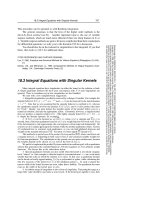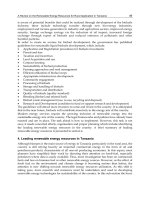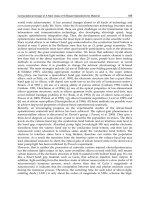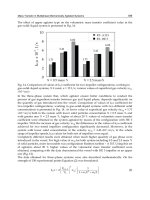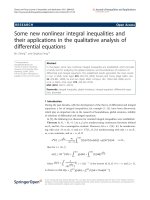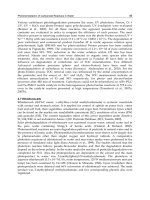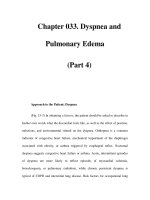Differential Equations and Their Applications Part 4 ppsx
Bạn đang xem bản rút gọn của tài liệu. Xem và tải ngay bản đầy đủ của tài liệu tại đây (776.43 KB, 20 trang )
50 Chapter 2. Linear Equations
where A, B, etc. are certain matrices of proper sizes. Note that we only
consider the case that Z does not appear in the drift here since we have
only completely solved such a case. We keep the notation .4 as in (2.13)
and let
(5.2) Ai = B~
0 ' C1 , l<i<d.
If we assume X(.) and Y(.) are related by (4.1), then, we can derive a
Riccati type equation, which is exactly the same as (4.23). The associated
BSDE is now replaced by the following:
(5.3) dp = [B - PB]pdt + E
qidWi (t), t
e [0, r],
p(T) = g.
Also, (4.13), (4.14) and (4.8) are now replaced by the following:
(5.4)
(5.5)
{
A=A+BP, b=Bp,
A~ = A~ + B~P
+ C~(I - PC~)-I(PA~ + PB~P),
_~ _ pc 1) (pB1 p + qi),
d
dX = (AX +b)dt + E(A~X + ai)dWi(t),
i=1
x(0) = 0,
l<i<d,
(5.6)
Our main result is the following.
Theorem 5.1. Let (4.22) hold and
(5.7) det{(O,I)eAtC~} >0,
t e [0, T],
Z i=(I-PC~)-I{(PA{+PBIP)X+PBlp+qi}, l<i<d.
vt c [o, T], 1 < i < d.
Then (4.23) admits a unique solution P(.) given by (4.25) such that
(5.8) [I - P(t)C~] -1 is bounded for t e [0, T], 1 < i < d,
and the FBSDE (5.1) admits a unique adapted solution (X, Y, Z) e ~4[0, T]
which can be represented by (5.5), (4.1) and (5.6).
The proof can be carried out similar to the case of one-dimensional
Brownian motion. We leave the proof to the interested readers.
Chapter 3
Method of Optimal Control
In this chapter, we study the solvability of the following general nonlinear
FBSDE: (the same form as (3.16) in Chapter 1)
dX(t) = b(t,
X(t),
Y(t), Z(t))dt + a(t,
X(t), Y(t),
Z(t))dW(t),
(0.1)
dY(t) = h(t, X(t),
Y(t),
Z(t))dt + Z(t)dW(t),
t E [0, T],
X(O) = x, Y(T) = g(X(T)).
Here, we assume that functions b, a, h and g are all deterministic, i.e., they
are not explicitly depending on w E ~; and T > 0 is any positive number.
Thus, we have an FBSDE in a (possibly large) finite time duration. As we
have seen in Chapter 1, w under certain Lipschitz conditions, (0.1) admits
a unique adapted solution (X(-), Y(-), Z(-)) E ~/[[0,T], provided T > 0 is
relatively small. But, for general T > 0, we see from Chapter 2 that even if
b, a, h and g are all afflne in the variables X, Y and Z, system (0.1) is not
necessarily solvable. In what follows, we are going to introduce a method
using optimal control theory to study the solvability of (0.1) in any finite
time duration [0, T]. We refer to such an approach as the
method of optimal
control.
w Solvability and the Associated Optimal Control
Problem
w An optimal control
problem
Let us make an observation on solvability of (0.1) first. Suppose (X(.),
Y(.),
Z(.)) E fld[0,T] is an adapted solution of (0.1). By letting y = Y(0) E
]R m, we see that
(X(.), Y(.))
satisfies the following FSDE:
dX(t) = b(t, X(t), r(t), Z(t))dt +
a(t,
X(t), Y(t), Z(t))dW(t),
(1.1)
dY(t) = h(t,
X(t), Y(t),
Z(t))dt + Z(t)dW(t),
t E [0, T],
x(0) = x, Y(0) =
with Z(.) E
Z[O,T]~=L 2 rO T'R m•
~ , , j being a suitable process. We note
that y and Z(-) have to be chosen so that the solution (X(-), Y(.)) of (1.1)
satisfies the following terminal constraint:
(1.2)
Y(T) = g(X(T)).
On the other hand, if we can find an y E Rm and a Z(.) E Z[0, T], such that
(1.1) admits a strong solution (X(.), Y(.)) with the terminal condition (1.2)
being satisfied, then
(X(.),Y(.),
Z(.)) E ~4[0, T] is an adapted solution of
(0.1). Hence, (0.1) is solvable if and only if one can find an y E ]R m
and a Z(.) E Z[0, T], Such that (1.1) admits a strong solution (X(.), Y(.))
satisfying (1.2).
52 Chapter 3. Method of Optimal Control
The above observation can be viewed in a different way using the
stochastic control theory. Let us call (1.1) a
stochastic control system
with
(X(.), Y(-)) being the
state process, Z(.)
being the
control process,
and
(x,y) 9 ~n x ~m
being the
initial state.
Then the solvability of (0.1) is
equivalent to the following
controllability
problem for (1.1) with the
target:
(1.3) T = {(x,g(x)) I x 9 ]RU}.
Problem (C). For any x 9 IR n, find an y 9 IR m and a control Z(.) 9
Z[0, T], such that
(1.4)
(X(T), Y(T)) 9 T,
a.s.
Problem (C) having a solution means that the state
(X(t),Y(t))
of
system (1.1) can be
steered
from {x} x Nm (at time t = 0) to the target T,
given by (1.3), at time t = T, almost surely, by choosing a suitable control
Z(-) 9 Z[0, T].
In the previous chapter, we have presented some results related to this
aspect for linear FBSDEs. We point out that the above controllability
problem is very difficult for nonlinear case. However, the above formulation
leads us to considering a related
optimal control problem,
which essentially
decomposes the solvability problem of the original FBSDE into several rel-
atively easier ones; and we can treat them separately. Let us now introduce
the optimal control problem associated with (0.1).
Again, we consider the stochastic control system (1.1). Let us make
the following assumption:
(H1) Functions
b(t, z, y, z), a(t, x, y, z), h(t, x, y, z) and g(x)
are contin-
uous and there exists a constant L > 0, such that for qo = b, a, h, g, it holds
that
Iqo(t, x, y, z) - qo(t, g, ~, 3) 1 _<
L(Ix
- 51 + lY - Yl + I z - zl),
(1.5) I~(t,0,0,0)l,
I~(t,x,y,O)l <_ L,
Vt9 T], x,~9 n, y,~9 z,g9
Under the above (H1), we see that for any (x, y) E]R '~ • I~
TM,
and Z(.) 9
Z[0, T], (1.1) admits a unique strong solution, denoted by, (X(.), Y(.)) _=
(X(-; x, y, Z(.)), Y(. ; x, y, Z(.))), indicating the dependence on (x, y, Z(.)).
Next, we introduce a functional (called
cost functional).
The purpose is
to impose certain kind of penalty on the difference
Y(T) - g(X(T))
being
large. To this end, we define
(1.6)
f(x,y)=,/l+ly-g(x)12-1, V(x,y) 9 ~ x ~ m .
Clearly, f is as smooth as g and satisfying the following:
(1.7)
~/(x, y) > O,
V(x, y) 9 ~ x ~m,
I
f(x,y) O,
if and only if y =
g(x).
w Solvability and the associated optimal control problem 53
In the case that (H1) holds, we have
If(x,Y) -
f(~,Y)I
~-Lix -~1 + [Y -Yl,
(1.8) V(x,y), (5,y) E IR n x IR m.
Now, we define the
cost functional
as follows:
(1.9)
g (x, y; Z (.) ) ~ E f ( X (T; x, y, Z(.) ), Y (T; x, y, Z(.) ) ).
The following is the
optimal control problem
associated with (0.1).
Problem (OC). For any given (x, y) C IR u x I~ m, find a Z(-) 9 Z[0, T],
such that
(1.10)
V(x,y) ~=
inf
J(x,y; Z(.)) = J(x,y;-Z(.)).
Z(.)~z[O,T]
Any Z(.) 9
Z[O,T]
satisfying (1.10) is call an
optimal control,
the
corresponding state process
(X(.), 9(.)) ~(X(. ; x, y, Z(-)), Y(.; x, y, 5(.)))
is called an
optimal state process.
Sometimes, (X(.), Y(-), Z(.)) is referred
to as an optimal triple of
Problem(OC).
We have seen that the optimality in
Problem(OC)
depends on the
initial state (x, y). The number
V(x, y)
(which depends on (x, y)) in (1.10)
is called the
optimal cost function
of
Problem(OC).
By definition, we have
(1.11)
V(x, y) >_ O,
V(x, y) 9 IR n x IR
TM.
We point out that in the associated optimal control problem, it is possible
to choose some other function f having similar properties as (1.7). For
definiteness and some later convenience, we choose f of form (1.6).
Next, we introduce the following:
(1.12) Af(V)-a-{(x,y) 9 R~ x R m [ V(x,y) = 0}.
This set is called the
nodal set
of function V. We have the following simple
result.
Proposition 1.1.
For z 9 ~, FBSDE (0.1) admits an adapted solution
if and only if
(1.13) N(V) N[{x} x IR "~] /
r
and
for
some (x, y) 9 H(V~ there
exists an optimal control Z(.) 9
Z[0, T],
such
that
(1.14)
V(x,y) = J(x,y; Z(.)) = O.
Proof.
Let (X(-), Y(-), Z(-)) 9 .hal[0, T] be an adapted solution of (0.1).
Let y = Y(0) 9 IR
TM.
Then (1.14) holds which gives (x,y) 9 N(V) and
(1.13) follows.
54 Chapter 3. Method of Optimal Control
Conversely, if (1.14) holds with some (x,y) E R n • Rm and Z(-) E
Z[0, T], then (X(.), Y(.), Z(-)) E Jl4[0, T] is an adapted solution of (0.1).
[]
In light of Proposition 1.1, we propose the following procedure to solve
the FBSDE (0.1):
(i) Determine the function V(x, y).
(ii) Find the nodal set Af(V) of V; and restrict x E R~ to satisfy (1.13).
(iii) For given x E IR ~ satisfying (1.13), let y E ]R "~ such that (x, y) E
Af(V). Find an optimal control Z(.) E Z[0, T] of Problem(OC) with the
initial state (x, y). Then the optimal triple (X(.), Y(.), Z(.)) E A/I[0, T] is
an adapted solution of (0.1).
It is clear that in the above, (i) is a PDE problem; (ii) is a minimizing
problem over ~m; and (iii) is an existence of optimal control problem.
Hence, the solvability of original FBSDE (0.1) has been decomposed into
the above three major steps. We shall investigate these steps separately.
w Approximate solvability
We now introduce a notion which will be useful in practice and is related
to condition (1.13).
Definition 1.2. For given x E R n, (0.1) is said to be approximately
solvable if for any ~ > 0, there exists a triple (X~(.), Y~ (-), Z~(-)) E A4[0, T],
such that (0.1) is satisfied except the last (terminal) condition, which is
replaced by the following:
(1.15) ElY,(T) - g(X~(T))[ < e.
We call (X~(-),Y~(-),Z~(-)) an approximate adapted solution of (0.1) with
accuracy ~.
It is clear that for given x E R~, if (0.1) is solvable, then it is approxi-
mately solvable. We should note, however, even if all the coefficients of an
FBSDE are uniformly Lipschitz, one still cannot guarantee its approximate
solvability. Here is a simple example.
Example 1.3. Consider the following simple FBSDE:
dX(t) = Y(t)dt + dW(t),
(1.16) dY(t) = -X(t)dt + Z(t)dW(t),
X(O) = x, Y(T) = -X(T),
with T = ~ and x ~ 0. It is obvious that the coefficients of this FBSDE are
all uniformly Lipschitz. However, we claim that (1.16) is not approximately
solvable. To see this, note that by the variation' of constants formula with
w Solvability and the associated optimal control problem 55
y Y(0), we have
X(t)) (cost sint~ (y)
Y(t) = -sint cost]
(1.17)
+for(cos(t-s) sin(t-s)
-sin(t-s) cos(t s)) ( 1
z(s) ) dW(s).
Plugging t = T = ~ into (1.17), we obtain that
/o
X(T) + Y(T) = -v~x + ~(s)dW(s),
where ~/is some process in L~=(0, T; ~). Consequently, by Jensen's inequal-
ity we have
ElY(T) - g(X(T))[ = E[X(T) + Y(T)[ _> [E[X(T) + Y(T)][ = vr2lx[ > 0,
for all (y, Z) E ~m x Z[0, T]. Thus, by Definition 1.2, FBSDE (1.16) is not
approximately solvable (whence not solvable). []
The following result establishes the relationship between the approxi-
mate solvability of FBSDE (0.1) and the optimal cost function of the asso-
ciated control problem.
Proposition 1.4. Let (H1) hold. For a given x 6 IR n, the FBSDE (0.1) is
approximately solvable if and only if the following holds:
(1.18) inf V(x,y) = O.
yER m
Proof. We first claim that the inequality (1.15) in Definition 1.2 can
be replaced by
(1.19) Ef(X~(T), Y~(T)) < e.
Indeed, by the following elementary inequalities:
(1.20) r A r____~ 2 < x/ri- + r2 _ 1 < r, Vr e [0, oo),
3
we see that if (1.15) holds, so does (1.19). Conversely, (1.20) implies
Ef(X~(T),Y~(T)) >_ ~E([Y~(T) - g(Ze(T))[2I(ly~(r)_g(X~(T))[<_l))
+
Consequently, we have
(I.21)
EIY~(T)-g(X~(T)) I < 3EI(X~(T), Y~(T))+x/3EI(X~(T), Y~(T)).
Thus (1.19) implies (1.15) with s being replaced by s' = 3e + x/~. Namely,
(1.18) is equivalent to the approximately solvability, by Definition 1.2 and
the definition of V. []
56 Chapter 3. Method of Optimal Control
Using Proposition 1.4, we can now claim the non-approximate solvabil-
ity of the FBSDE (1.16) in a different way. By a direct computation using
(1.21), one shows that
J(x,y; Z(.)) = Ef(X(T), Y(T))
> [ v lxl+ -5] >0, VZ(.)9
Thus,
1 i 1 12
V(x,y)_>5[ v@xl+ -7] >0,
violating (1.18), whence not approximately solvable.
Next, we shall relate the approximate solvability to condition (1.13).
To this end, let us introduce the following supplementary assumption.
(H2) There exists a constant L > 0, such that for all (t,x,y,z)
9
[0, T] x ]1:~ n x ]R m x
~:~mxd
one of the following holds:
Ib(t,x,y,z)l + la(t,x,y,z)l <
L(1 + Ixl),
(1.22)
(h(t,x,y,z),y) >
-L(1 + Ixl lYl + lY12),
(1.23)
(h(t,x,y,z),y) >
-L(I+ [y[2),
Ig(x)l <_ L.
Proposition 1.5. Let
(HI) hold. Then (1.13) implies (1.18); conversely,
if V(x, .) is continuous, and (H2) holds, then (1.18) implies (1.13).
Proof.
That condition (1.13) implies (1.18) is obvious. We need only
prove the converse. Let us first assume that V is continuous and (1.22)
holds.
Since (1.18) implies the approximately solvability of (0.1), for every
c E (0, I], we may let (X~,Y~, Z~)
r
J~4[0, T] be the approximate adapted
solution of (0.I) with accuracy c. Some standard arguments using ItS's
formula, Gronwall's inequality, and condition (1.22) will yield the following
estimate
(1.24)
EIX~(t)I 2 <_
C(1 + ]x12), Vt r [0, T], c 9 (0, 1].
Here and in what follows, the constant C > 0 will be a generic one, de-
pending only on L and T, and may change from line to line. By (1.24) and
(1.15), we obtain
E[Y~(T)I < EIg(X~(T)) I + ElY,(T) - g(X~(T)) I
(1.25)
_< C(1 + Ixl) +E _< C(1 + Ixl).
w Dynamic programming method and the HJB equation 57
Next, let (x) ~ ~/1 + [xl 2. It is not hard to check that both D (x) and
D 2 (x) are uniformly bounded, thus applying It6's formula to (Yc(t)), and
note (1.22) and (1.24), we have
E(Y~(T))-E(Y~(t))
~t T 1 { (Y~(s),h(s, Xe(s),Ys(s),Ze(s)))
=E (Y~(s))
(1.26)
+I[Iz~(s)I2 IZ~(s)T(y~(s))
>_ -LEFT(1 + IX~(s)l +
< Y~(s)))ds
Jt
F
___ -C(l+lxl)-LE
(Y~(s))ds, Vte
[0,T].
Jt
Now
note that lYl (Y) 1 + lYl, we have
by Gronwall's inequality and
(1.25) that
(1.27)
E(Y~(t))<_C(I+Ixl),
Vt e [0,TI, s e (0,1].
In particular, (1.27) leads to the boundedness of the set {IY~ (0)1}~>o. Thus,
along a sequence we have Y~ (0) ~ y, as k -~ oo. The (1.13) will now follow
easily from the continuity of
V(x, .)
and the following equalities:
(1.28)
0 < V(x, Y~
(0)) _<
Ef(X~ k (T), Y~ (T)) < ek.
Finally, if (1.23) holds, then redoing (1.25) and (1.26), we see that
(1.27) can be replaced by E(Y~(t) } <_ C, Vt C [0,T], e E (0, 1]. Thus the
same conclusion holds. []
We will see in w that if (H1) holds, then
V(., .)
is continuous.
w Dynamic Programming Method and the HJB Equation
We now study the optimal control problem associated with (0.1) via the
Bellman's
dynamic programming method.
To this end, we let s E [0, T) and
consider the following controlled system (compare with (1.1)):
dX(t) = b(t, X(t), Y(t), Z(t))dt + a(t, X(t), Y(t), Z(t))dW(t),
(2.1)
dY(t) = h(t, X(t), Y(t), Z(t))dt + Z(t)dW(t), t c [s, T],
x(s) = x, Y(s) = y,
Note that under assumption (H1) (see the paragraph containing (1.5)), for
any
(s,x,y) e
[0, T) x IR n x IR m and Z(.) 6
Z[s,T]A=L~(s,T;IRm•
equation (2.1) admits a unique strong solution, denoted by,
(X(.), Y(.)) =-
(X(.; s, x, y, Z(.)), Y(-; s, x, y, Z(.))). Next, we define the cost functional as
follows:
(2.2)
J(s,x,y;Z(.)) Z~ Ef(X(T;s,x,y,Z(.)),Y(T;s,x,y,Z(.))),
58 Chapter 3. Method of Optimal Control
with f defined by (1.6). Similar to
Problem(OC),
we may pose the follow-
ing optimal control problem.
Problem (OC)~. For any given
(s,x,y) 9
[0, T) x ]R ~ x Rm, find a
Z(.) 9 Z[s, T],
such that
(2.3)
Y(s, x, y) ~
inf
.J(s, x, y; Z(.)) = J(s, x, y;-Z(.)).
z(.)cz[~,T]
We also define
(2.4)
V(T,x,y) = f(x,y),
(x,y) e ]R n x lR m.
Function
V(.,., .)
defined by (2.3)-(2.4) is called the
value function
of the
above family of optimal control problems (parameterized by s E [0, T)). It
is clear that when s 0,
Problem(OC)s
is reduced to
Problem(OC)
stated
in the previous section. In another word, we have embedded
Problem(OC)
into a family of optimal control problems. We point out that this family of
problems contains some very useful "dynamic" information due to allowing
the initial moment s E [0, T) to vary. This is very crucial in the dynamic
programming approach. From our definition, we see that
(2.5) = v(x,y), 9 •
Thus, if we can determine
V(s,x,y),
we can do so for
V(x,y).
Recall
that we called
V (x, y)
the
optimal cost function
of
Problem( OC),
reserving
the name
value function
for
V(s, x, y)
for the conventional purpose. The
following is the well-known
Bellman's principle of optimality.
Theorem 2.1.
For any 0 < s < ~ < T, and
(x,
y) 9 ]R n
• ]R m,
it holds
(2.6)
Y(s,x,y)=
inf
EY('g,X('~;s,x,y,Z(.)),Y('~;s,x,y,Z(.))).
Z(.)eZ[s,T]
A rigorous proof of the above result is a little more involved. We present
a sketch of the proof here.
Sketch of the proof.
We denote the right hand side of (2.6) by
V(s, x, y).
For any z(.) C Z[s,T], by definition, we have
Y(s, x, y) ~ J(s, x, y; Z(.))
= EJ(~,
X(~'; s, x, y, Z(-)), Y(~'; s, x, y, Z(-)); Z(.)).
Thus, taking infimum over Z(.) E
Z[s,
T], we obtain
(2.7)
Y(s, x, y) (_ V(s, x, y).
Conversely, for any 6 > 0, there exists a Z~(.) C
Z[s,T],
such that
Y(s, x, y) + e >_
J(s, z, y; Z~(.))
= EJ('~,
X(~';
s, x, y, Z~(.)),
Y(~';
s, x, y,
Z~(.)); Z~ (.))
(2.8)
~ EV('~,X('~;s,x,y, Zs(.)),Y(~g;s,x,y,Z~(.)))
V(s, x, y).
w Dynamic programming method and the HJB equation 59
Combining (2.7) and (2.8), we obtain (2.6). []
Next, we introduce the
Hamiltonian
for the above optimal control prob-
lem:
{
7t(s'x'y'q'Q'z)~= (q'\h(s,x,y,z) )
(2.9) +~trl
[Q(a(s,x,y,z z)) (cr(s,x,y,z z))T]},
v(s,x,v,q,Q,.) 9 [0,T] • •
X ~n+m X ~n+m X ~mxd
and
(2.10)
H(s,x,y,q,Q)=
inf
7t(s,x,y,q,Q,z),
zCR m•
V(s, x, y, q, Q) 9 [0, T] x R n x R'~ x Rn+m x
S '~+m,
where S n+m is the set of all (n + m) x (n + m) symmetric matrices. We
see that since ~m• is not compact, the function H is not necessarily
everywhere defined. We let
(2.11)
I)(H) ~={(s,x,y,q,Q) [ H(s,x,y,q,Q) > -~}.
From above Theorem 2.1, we can obtain formally a PDE that the value
function V(.,-, .) should satisfy.
Proposition 2.2.
Suppose V(s,x,y) is smooth and H is continuous in
Int :D(H). Then
(2.12)
Vs(s,x,y) + H(s,x,y, DV(s,x,y),D2V(s,x,y))
= 0,
for a11 (s, x, y) 9
[0, T) x ~n • ]R m,
such
that
(s, x, y,
DV(s, x, y), D2Y(s, x, y)) 9
Int
T)(H),
(2.13)
where
DY= Vy ' Vx T Vyv
Proof.
Let (s, x, y) E [0, T) • ~n • iRm such that (2.13) holds. For any
z 9 IR re•
let (Z(.), Y(.)) be the solution of (2.1) corresponding to (s, x, y)
and Z(.) - z. Then, by (2.6) and It6's formula, we have
o<_ - V(s,x,y) }
(2.14) -
+ Vs(s,x,y) + 7{(s,x,y, DV(s,x,y),D2V(s,x,y),z).
Taking infimum in z 6 IR "~• we see that
(2.15)
Vs(s,x,y) + H(s,x,y, DY(s,x,y),D2Y(s,x,y)) >0.
60 Chapter 3. Method of Optimal Control
On the other hand, for any E > 0 and ~ G
(s,T),
by (2.6), there exists
a Z(.) - Z~(.) C Z[s,T],
with the corresponding state being
(X(.),Y(.)),
such that
(2.16)
> E{V(~,x(~),Y(~))-V(s,~,Y)}
= 1 E V~(t,X(t),Y(t))
~-s
+ ~t (t, X(t), Y(t), DV(t, X(t), Y(t)), D2V(t, X(t), Y(t)), Z(t))) }dr
I
>_ ^ E V~(t,X(t),Y(t))
8 8
+ H(t, X(t), Y(t), DV(t, X(t), Y(t)), D2V(t, X(t), Y(t))) }dt
-+ Vs(s,x,y) + H(s,x,y, DV(s,x,y),D2V(s,x,y)).
Here, we have used (2.13) and the assumption that H is continuous in
Int ~(H). Combining (2.15)-(2.16), we obtain (2.12). []
Equation (2.12) is called the
Hamilton-Jacobi-Bellman
(HJB for short)
equation
associated with our optimal control problem. In principle, one
can determine the value function V(.,-,-) through solving (2.12)-(2.13)
together with the terminal condition (2.4). However, since :D(H) might
be a very complicated set, solving (2.12)-(2.13) together with (2.4) is very
difficult. Thus, much more needs to be done in order to determine the value
function V.
w The Value Function
In this section, we are going to study the value function V introduced in
the previous section in some details.
w Continuity and semi-concavity
We first look at the continuity of the value function
V(s, x, y).
Note that
since the control domain ~{mxd is not compact, we can only prove the
right-continuity of
V(s, x, y)
in s E [0, T).
Proposition 3.1.
Let (H1) hold. Then V(s,x,y) is right-continuous in
s E [0,
T) and there exists a constant C > O, such that
0 < V(s,x,y)
_<C(1 + Ixl + lYl),
(3.1)
V(s, ~, y) e [0, T] • ~n •
~,
(3.2)
IV(s, x, y) - V(s,~,y)l < C(Ix -~l + ly -yl),
VsE[0, T], x,~E]R n, y,~CIR m.
Proof.
It is clear that for any (s, x, y) E [0, T] x IR n x ~m, we have
0 <_ V(s,x,y) <_ J(s,x,y;O)
_< C(1 +
Ixl
+ lyl).
w The value function 61
This proves (3.1).
Next, let s E [0, T] and (x, y), (5, ~) E IR ~ x ~m be fixed. Then, for
any Z(.) E Z[s, T], by ItS's formula and Gronwall's inequality, using (H1),
we have
EIX(t; s, y, Z(.)) - X(t; s, 5, Z(.))12
(3.3) + ElY(t; s, x, y, Z(.)) - Y(t; s, 5,~, Z(.))12
<C{Jx'-~[Z+Jy-~[2}, t E [s,T],
with C > 0 only depending on L and T. Then (3.2) follows from (1.8),
which implies the (Lipschitz) continuity of V(s, x, y) in (x, y).
We now prove the right-continuity of V(s, x, y) in s E [0, T]. First of
all, it is clear that for any Z(-) E Z[O,T], the function
(8,x,y)
J(8, x,y;ZJi,,Tl(.))
is continuous. Thus, by the definition of V, it is necessary that V(s, x, y)
is upper semi-continuous. On the other hand, by (2.6) and (3.2), taking
Z(.) = 0, we have
(3.4) V(s, x, y) < V(~g, x, y) + C(~ - s) 1/2, V0 < s < ~" < T.
Thus, by the upper semi-continuity of V, we must have
lim Y(~', x, y) = Y(s, x, y),
which gives the right-continuity of V in s E [0, T). []
From (2.5) and (3.2), we see that under (H1), the function V(x,y) is
continuous, the assertion that we promised to prove in w
Next, we would like to establish another important property for the
value function. To this end, we introduce the following definition.
Definition 3.2. A function ~o : IR '~ -+ ~ is said to be semi-concave if there
exists a constant C > O, such that the function (I)(x) - ~o(x) - Cix[ 2 is
concave on ]R n, i.e.,
(3.5) ~()~x + (1 - ),)5) _> AO(x) + (1 - ;~)~(~), V)~ E [0, 1], x,5 E IR ~.
A family of functions ~E : ~n __+ IR is said to be semi-concave uniformly in
e if there exists a constant C > 0, independent of 6, such that ~o~(x) -CIx] 2
is concave for all c.
We have the following result.
Lemma 3.3. Function ~ : IRn -+ lit is semiconcave if and only if
)~(x) + (1 - A)~o(5) - ~()~x + (1 - ),)5) < CA(1 -'A)Ix - 512,
(3.6) VA E [0, 1], x, 5 E ~.
2,1 n
In the case that ~ E Wto ~ (IR ), it is semiconcave if and only if
(3.7) D2~(x) _< CI, a.e. x E ]R n,
62 Chapter 3. Method of Optimal Control
where D2~ is the (generalized) Hessian of ~ (i.e., it consists of second order
weak derivatives of ~).
Proof.
We have the following identity:
Alxl = + (1
-
A)I~I = - lax + (1 - A)~I = = A(1
-
A)lx - ~1 =,
VA E [0, 1], x, 5 E Ft".
Thus, we see immediately that (3.5) and (3.6) are equivalent.
Now, if ~ is C 2, then, by the concavity of qo(x) - C[x[ 2, we know that
(3.7) holds. By Taylor expansion, we can prove the converse. For the
general case, we may approximate ~ using mollifier. []
It is easy to see from the last conclusion of Lemma 3.3 that if ~ has a
bounded Hessian, i.e., ~ is uniformly Lipschitz, then, it is semi-concave.
This observation will be very useful below.
Let us make some further assumptions.
(H3) Functions b, a, h and g are differentiable in (x, y) with the deriva-
tives being uniformly Lipschitz continuous in (x, y) E ~n x ]R m, uniformly
in (t,z) E [0, T] x
]F~ m•
We easily see that under (H3), the function f defined by (1.6) has a
bounded Hessian, and thus it is semi-concave.
Now, we prove the following:
Theorem 3.4.
Let (H1) and (H3) hold. Then the value function V(s, x, y)
is semi-concave in
(x,
y) E ~t n x lit m uniformly in
s E [0, T].
Proof.
Let s E [0,T),
xo, xl
E ~ and
Yo,Yl
E ~'~. Denote
(3.8) xx : Axl + (1 - A)x0, yx : Ayl + (1 - A)yo, A E [0, 1].
Then, for any ~ > 0, there exists a Ze(-) E
Z[s, T]
(which is also depending
on A), such that
(3.9)
J(s, xx,y~;Z~(.)) < V(s, xx,y~) + ~.
We now fix the above Ze(') and let (X~(.), Y~(-)) be the solution of (2.1)
corresponding to (s, xx,
y~, Z~(.)).
We denote
(3.10)
{ ~(r) = (X~(r), Y~(r)),
Cx(r) = Arh(r ) + (1 - A)r/o(r),
A E [0,1], r E Is, T].
Using ItS's formula and Gronwall's inequality, we have
(3.11)
EIXI(t ) -
Xo(t)[ 4 +
EIYI(t ) -
Yo(t)I 4 _<
c(Ixl - xol'
+ lyl - yoI4) 9
w The value function 63
Since
f(x, y)
is semi-concave in (x, y) (by (H3)), we have
AV(s, xl,yl) +
(1 -
A)Y(s, xo,Yo) - Y(s, xx,yx) -
< ~J(s,xl,yl; z~(.)) + (1 - ~)J(s, x0,~o; z~(.))
(3.12) . -
J(s, xx,y:~; Z~(.))
EIAf(~h(T)) +
(1 - A)f(~o(T)) -
f(yx(T))~
<_ CE{A(1 - A)I,1 (T) - ,0(T)l 2 + ]~x(T) - ,x(T)I2}.
Let us now estimate the right hand side of (3.12). For the first term, we
have
(3.13) E]rh(t)
?']0(t)[ 2 5 C(Ixl - Xol 2 -[- [Yl - yo[2),
t 9 [8,T].
To estimate the second term on the right hand side of (3.12), let us denote
{ bx(r) = b(r,~?x(r),
Ze(r)),
(3.14)
hx(r) = h(r,,u (r), Z~ (r)), ;~ 9
[0, 1], r 9 Is, T].
~x(r) = ~(r, ~x(r), z~(r)),
Then, applying It6's formula, one has (we suppress r in the integrand below)
E l~x(t)
-
~x(t) l ~
= 2E ( AX1 + (1 - A)Xo - Xx, Abl + (1 - A)bo
- bx > dr
(3.15) ft
+ 2E ( AY1 + (1 - A)Yo - Yx, Ahl + (1 - A)ho
- hx ) dr
,'8
-I- E I)~o'1 + (1 - A)ao -
ax]2dr,
t 9 [s, T].
Note (we suppress r and Z~ (r) from the second line on)
IAbl(r) + (1 - A)bo(r) -
bx(r)l
= [Ab(rh) + (1 - ),)b(r/o) - b(r~),)[
_< IA[b(rh) - b(~x)] + (1 - A)[b(r/o) - b(t~x)]l + L[~x - r/x[
(3.16) = A
(bn(~x+a(1-A)(~l-~?o))da,(1-A)(~l-~o))
+ Ll~x - vxl
_ CA(1 - A)I~I - ~o12 + LISx - ~xl-
We have the similar estimates for the terms involving h and a. Then it
64 Chapter 3. Method of Optimal Control
follows from (3.13) and (3.15) that
El~(t) -
rl~(t)] 2 < CA2( I - A)2(Ixl - xol 2 +
ly~ - yol=) z
['
+ c El~(r) - V~(r)12ar, Vt e [s,T].
By applying Gronwall's inequality, we obtain
(3.17) El~,(t) - ~x(t)l 2 -< CA2( 1 - "~)2(IXl - Xol 4 + lYl - yo14) 9
Combining (3.12),
(3.13)
and (3.17), we obtain the semi-concavity of
V(s, x, y)
in (x, y), uniformly in s E [0, T]. []
w Approximation of
the value
function
We have seen that due to the noncompactness of the control domain
~:~raxd,
it is not very easy to determine the value function V through a PDE (the
HJB equation). In this subsection, we introduce some approximations of
the value function, which will help us to determine the value function (ap-
proximately).
First of all, let W(t)
= (Wl
(t), W2 (t))
be an (n + m)-dimensional Brow-
nian motion which is independent of
W(t)
(embedded into an enlarged
probability space, if necessary) and let {:~t}t_>o be the filtration generated
by
W(t)
and W(t), augmented by all the P-null sets in ~ Define
(3.18)
{ z0[s, T] A- Z[s, T],
Zo[S, T] A-{Z: Is, T] x Q ~
Rm• ] Z
is {5~t}t_>0-adapted ,
fTEIz(t)12dt < ~ }.
Next, for any 5 > 0, we define
{ Zz[s,T]A-{Z E Z[s,T] I IZ(t) I < 5'
2z[s,T] A-{Z E
2ofs, T] l lZ(t)l < ~,
(3.19)
The following inclusions are obvious.
a.e.t E Is, T], a.s. },
a.e. t E [s, T], a.s. ).
(3.21)
Z(t,w), if IZ(t,o,)l __% ~,
Z~(t,~)
= Z(t,~) 1
51Z(t,o,)l' if IZ(t,o,)l > ~.
In what follows, for any Z E
Zo[s,T]
(resp. Zo[s,T]) and 5 > 0, we
define the
[-truncation
of Z as follows:
Zo[s,T] D Z~,[s,T] D Z~[s,T]
(3.20) n n N V52 _> 51 _> 0.
~'0 [S, T] ~ 281 [S, T] D
Z~2 [s, T]
w The value function 65
Clearly,
Z~ 9 Z~[s,T]
(resp. Z.~[s,T]).
We now consider, for any ~ > 0, the following
regularized state equation
(compare to (2.1)):
dX(t) = b(t, X(t),
Y(t),
Z(t))dt +
a(t, X(t), Y(t),
Z(t))dW(t)
+ v~dW1 (t),
(3.22)
dY(t) = hit, X(t),
Y(t),
Z(t))dt + Z(t)dW(t)
+ V~i~d~(t), t 9 [~, T],
x(s) = ~, Y(s) = y.
Define the cost functional by
J~'~(s,x,y;Z(.))
(resp.
]~,~(s,x,y;Z(.)))
which has the same form as (2.3) with the control being taken in
Zz[s,T]
(resp. Zs[s,T]) and the state satisfying (3.22), indicating the dependence
on 5 ~ 0 and r >_ 0. The corresponding optimal control problem is called
Problem (OC)~ '~
(resp.
Problem (OC)~ ).
The corresponding (approxi-
mate) value functions are then defined as, respectively,
(3.23)
{
VS'*(s,x,y)
= in f
JS'~(s,x,y;Z(.)),
Z(.)EZ~[s,T]
y~,~(s,~,y) inf J~'~(~,x,y; Z(-)).
Z(.)EZ~[s,T]
Due to the inclusions in (3.20), we see that for any (s, x, y) 9 [0, T] • ]R" x
]R m ,
i3.24)
{
V 5'~(s,x,y) >VS'~(s,x,y) >0, V5,6>0,
k'52'~is, x,y ) > l/5"~(s,x,y), V52 >__ 51 > O, ~ >_
0,
V~2'~(s,x,y) >_ VS~'~(s,x,y),
V52 >__ 5~ _> 0, e k 0.
Also, it is an easy observation that
V~176 = V(s,x,y), V(s,x,y).
Note that for 5 > 0 and c > 0, the corresponding HJB equation for the
value function V~'~ (s, x, y) takes the following form:
(3.25)
{
Vf'~ +r 5'~
+ HS(s,x,y,DVS'~,D2~V ~'~) = O,
(s,x,y) 9 (0,T) • ~n x ~m;
#~'~(T,x,y)
= f(~,y), (x,y) 9 ~" x ~m,
where A is the Laplacian operator in IR n+m, and H 5 is defined by the
following:
H~(s,x,y,q,Q) ~=
( b(s,x,y,z) ~
inf
{ (q' h(s,x,y,z)] )
zER mXd
+ ltr [Q (a(s'x;Y'Z) ) (a(s'x;Y'z) )T] } ,
66 Chapter 3. Method of Optimal Control
for (s, x, y, q, Q) E [0, T] x ]R n x R m x R,~+m X S n+m, where S '~+m is the
set of all (n + m) x (n + m) symmetric matrices. We observe that for c > 0,
(3.25) is a nondegenerate nonlinear parabolic PDE; and for z = 0, however,
(3.25) is a degenerate nonlinear parabolic PDE. The following notion will
be necessary for us to proceed further.
Definition 3.5. A continuous function v : [0, T] x ~1. ~ x ~m _> ]1% is called
a viscosity subsolution (resp. viscosity supersolution) of (3.25), if
v(T, x, y) <_ f(x, y), Y(x, y) E R ~ x R m,
(3.26)
(resp. v(T, x, y) >_ f(x, y), V(x, y) E ]R ~
x
Rm),
and for any smooth function ~(s, x, y) whenever the map v - ~ attains a
local maximum (resp. minimum) at (s, x, y) E [0, T) x R n x R m, it holds:
us(s, x, y) + ~a~(s, x, y)
(3.27)
+ SS(s,x,y,D~(s,x,y),D2~(s,x,y)) >_ O (resp.<0).
If v is both viscosity subsolution and viscosity supersolution of (3.25), we
call it a viscosity solution of (3.25).
We note that in tile above definition, v being continuous is enough.
Thus, by this, we can talk about a solution of differential equations without
its differentiability. Furthermore, such a notion admits the uniqueness.
The following proposition collects some basic properties of the approx-
imate value functions.
Proposition 3.6. Let (H1) hold. Then
(i) ~,~(s, ~, y)
and V ~,~(s, x, y) are continuous in
(x, y) 9 ~" • ~m,
uniformly in s C [0, T] and 6, E >_ O; For fixed 6 > 0 and e > O, ~5,~ (s, x, y)
and Va'~(s,x,y) are continuous in (s,x,y) 9 [0, T] x Rn • Rm.
(ii) For 6 > 0 and ~ >_ O, Va'e(s, x, y) is the unique viscosity solution of
(3.25), and for 6,r > O, Va'e(s,x,y) is the unique strong solution of (3.25).
(iii) For 6 > 0 and r >_ O, Va'~(s,x,y) is a viscosity super solution of
(3.25), V~'~ is the unique viscosity solution of (3.25) (with r = 0).
The proof of (i) is similar to that of Proposition 3.1 and the proof of
(ii) and (iii) are by now standard, which we omit here for simplicity of
presentation (see Yong-Zhou [1] and Fleming-Soner [1], for details).
The following result gives the continuous dependence of the approxi-
mate value functions on the parameters 6 and r
Theorem 3.7. Let (1tl) hold. Then, for any s 9 [0, T], there exists a
continuous function ~s : [0, oo) x [0, oo) + [0, co), with ~s(O,r) = 0 for all
r >_ O, such that
IP,~(s, x, y) - #~,~(s, x, y)l _< ~(l~ - 31 + IE - ~l, Ixl + lyl),
(3.28) IP'~(s, ~, y) - v~'~(s, ~, y)l _< ~(l~ - ~l + IE - gl, I~l + lyl),
V(s,
x,
y) 9 [0, T] x Rn x
Pf~,
5,
6,
c, g 9 [0, 1].
w The value function 67
Proof.
Fix (s, x, y) E [0, T] x IR n x Rm, 5, 5, s, f > 0, and
Z C Z[s, T].
Let Z~ (resp. Z$) be the 1/5- (resp. 1/5-) truncation of Z; and (X, Y) (resp.
A
(X,Y)) the solution of (3.22) corresponding to (s, Z~) (resp. (g, Z$)). By
It6's formula and Gronwall's inequality,
E{[X(T) -
_~(T)] 2 + ]Y(T) - Y(T)I 2 }
(3.29) fs T
< C{E
[Ze(t) -
Z$(t)ledt
+ [x/~ - v~12},
where C > 0 depends only on L and T. Thus, we obtain
IV~,~(~, ~, y) - v~,~(s, ~, y)l
(3.30)
< CIv'~- v'-~l, V(s,~,y), 5,s,~ >_
0.
Combining with Proposition 3.6, we see that
V~,~(s, x, y)
is continuous in
(s, x, y) 9 [0, co) x l{ n x IR m uniformly in 5 _> 0 and s e [0, T].
Next, for fixed (s, x, y) 9 [0, T] x IR '~ x l{ m, s _> 0, and 5 > 5 > 0, by
(3.24), we have
(3.31)
o <_ y~,~(s,x,y) -ve,~(s,x,y).
On the other hand, for any 5 > 0, and So > 0, we can choose
Z ~~ 9 Z~[s,T]
so that
(3.32)
V~'~(s, x, y) + r > J~'~(s, x, y; Z~~
Let Z~ ~ be the 1-truncation of Z ~~ and denote the corresponding solution
A A
of (3.22) with Z ~~ (resp. Z~ ~ by
(X~~ ~~
(resp.
(X~~176
Setting
(X,Y) = (X~~176
(X,Y) = (2~o,Y~o), s = g, Z~ = Z ~~ and Z$ = Z~ ~
in (3.29), we obtain
E{tX~O(T) -
2~O(T)l: + IY~~ - ~2~o (T)[: }
(3.33) fT
<_ CE [Z~~ - Z~~
aS
We consider the following two cases:
Case
i. 5 > 0. In this case, note that
IZ~~ - Z~~ <_
[1/5 - 1/51,
a.e.t E
Is,T],
a.s. By (1.8) and (H1), one easily checks that
z 0/> c
(3.34)
1 1
>V ~,~(s,x,y)-C ~-~.
Combining (3.31), (3.32) and (3.34), we obtain (note So > 0 is arbitrary)
0 < V~'~(s,x,y)- V~'~(s,x,y)l < C ~ - ~1~
(3.35) -
V(s,z,y),
5,~ > O, s > O,
68 Chapter 3. Method of Optimal Control
where C is again an absolute constant.
Case
2. 5 = 0. Now let 5 > 0 be small enough so that the right side of
(3.33) is no greater than ~. Then, similar to (3.36), we have
(3.36)
J~ Z ~~ >_ V~"~(s,x,y) - Eo.
Combing (3.31), (3.32) and (3.36), one has 0 <
V$'~(s, x, y)
-V~ x, y) <
2~0, which shows that
(3.37)
V$'~(s,x,y)$V~ 550.
Since
V~ x, y)
is continuous in (~, x, y) (see (3.30) and Proposition 3.6-
(i)), by Dini's theorem, we obtain that the convergence in (3.37) is uniform
in (r x, y) on compact sets. Thus, for some continuous function qs : [0, co) •
[0, co) -+ [0, co) with ~s (0, r) = 0 for all r _> 0, one has
o < - <_
Ixl + lyl),
(3.38)
V(s,x,y), c e [0, 1], 3 _> 0.
Combining (3.30), (3.35) and (3.38), we have that
V~,~(s, x, y)
is continuous
in (5, e, x, y) E [0, co) x [0, co) x B. n • ~m. The proof for ~,e is exactly
the same. []
Corollary 3.8.
Let (H1) hold.
Then
(3.39)
V~'~ = V~'~ V(s,x,y) e
[0, T] • ]R n • ]R m, 5 _> 0.
Proof.
If 6 > 0, then both ~5,0 and V ~'~ are the viscosity solutions of
the HJB equation (3.25). Thus, (3.39) follows from the uniqueness. By the
continuity of ~,0 and V a,~ in 5 > 0, we obtain (3.39) for 5 = 0. []
Corollary 3.9.
Let V(O, x, y) = O. Then, for any
g > 0,
there exist 5, ~ > 0
and Z~,6(.) E Zs[O, T]
satisfying
(3.40)
J~'~(O,x,y;
Z~'~(.)) < g,
such that, is
(X~,~(.),Ya,~(.))
is the solution of (2.1) with
Z(.) = Z~'~(.),
then the triplet
(X~,~,Y 5,~, Z ~,~)
is an approximate solution of (1.1) with
accuracy 3g + yrS.
Proof.
Let
V(O,x,y)
= 0. Since V = V ~176 by Theorem 3.7, there
exist 5,r > 0, such that
VS,~(O,x,y)
< g. Now by (3.9) we can find a
Z ~'a C Zs[0, T] such that (3.40) is satisfied. Let (X a,~, Y~,~) be the solutions
of (2.1) with s = 0, and Z = Z 5'~. Then we have (see (1.21))
EIyS,~ (T) - g( XS,~ (T) ) I
<_ 3Ef(X~'~(T), Ya'~(T)) + v/3Ef(X~,~(T),
Y~,~(T))
= 3JS,~(O,x,y; Z~'~(.)) + v/3g~,~(O,x,y; Z~,~(.))
<
w A Class of Approximately Solvable FBSDEs 69
This proves our assertion. []
To conclude this section, we present the following result.
Proposition 3.10. Let (H1) and (H3) hold. Then V~'~(s,x,y) is semi-
concave uniformly in s 9 [0, T], 5 9 (0, 1] and c 9 [0, 1]. In particular, there
exists a constant C > O, such that
(3.41) AyVh'~(s,x,y) <_ C, V(s,x,y) 9 [0, T] • ~n • ~m, 6,E 9 (0,1],
m
where Ay = ~j=l 02
yj"
Proof. The proof of the first claim is similar to that of Theorem 3.4.
To show the second one, we need only to note that by (3.7),
AyV 5'~ =tr{ (0 0 ~)D2V ~'~ (0 0 0i)} ~ C,
which gives (3.41). []
w A Class of Approximately Solvable FBSDEs
We have seen from Proposition 1.4 that if (1.13) holds, then (0.1) is ap-
proximate solvable. Further, from w we see that if (x, y) C
]R n X ~:~m
is
such that V(0, x,y) 0, then one can actually construct a sequence of
approximate solutions to (0.1). Finally, (1.13) is also an important step of
solving (0.1) (see Proposition 1.1). In this section, we look for conditions
under which (1.13) holds. Moreover, we would like to construct the nodal
set Af(V) for some special and interesting cases.
In what follows, we restrict ourselves to the following FBSDE:
dX(t) = b(t, X(t), Y(t))dt + a(t, X(t), r(t))dW(t),
(4.1) dY(t) = h(t, X(t), Y(t))dt + Z(t)dW(t), t C [0, T],
X(O) = x, Y(T) : g(X(T)).
The difference between (0.1) and (4.1) is that in (4.1)__, the functions b, a
and h are all independent of Z. To study the set A/'(V), we introduce the
nodal set of value function V(s, x, y):
A/'(V) {(s,x,y) 9 [0, T] x Ill n x ~m I V(s,x,y) = 0 }.
(4.2)
Clearly,
(4.3)
{0} • N(v) = N(v) N [{0} • •
We will study A/(V) below, which will automatically give the information
on A/'(V) that we are looking for.
Let us now first make an observation. Suppose there exists a function
: [0, T] • IR ~ -+ ~'~, such that
(4.4) V(s, x, 0(s, x)) = 0, V(s, x) E [0, T] • ~,

